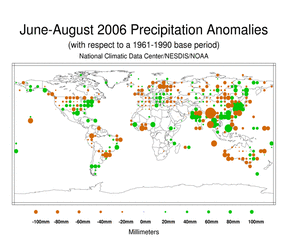Global Highlights:
|
Contents of this Section: |
| The data presented in this report are preliminary. Ranks and anomalies may change as more complete data are received and processed. The most current data may be accessed via the Global Surface Temperature Anomalies page. |
Temperature anomalies for June - August and August 2006 are shown
on the dot maps below. The dot maps, below left, provide a spatial
representation of anomalies calculated from the Global
Historical Climatology Network (GHCN) data set of land surface
stations using a 1961-1990 base period. The maps, below right, are
products of a merged land surface and sea surface temperature
anomaly analysis, which is based on data from the GHCN of land
temperatures and the Comprehensive Ocean-Atmosphere Data Set
(COADS) of Sea-Surface Temperature (SST) data. Temperature
anomalies with respect to the 1961-1990 mean for land and ocean are
analyzed separately and then merged to form the global analysis.
Additional information on this product is available. |
 larger image |
 larger image |
| During August, there
were above average temperatures across much of the United States,
Brazil, Scandinavia, the Middle East and Asia. Cooler than average
temperatures were observed primarily in Russia, Alaska and the U.S.
far Northeast. During January-August 2006, there were above average temperatures in the majority of North America, China, western Europe, South America and Africa. Cooler than average temperatures were observed in Alaska and western Australia. In January-August, warmer than average SSTs occurred in the South Pacific, North and South Atlantic and southern Indian Oceans, with cooler than average conditions observed in the North Pacific and off the coast of western Australia. In August, warmer than average SSTs occurred in the North Atlantic and the Niño 1+2 region, with cooler than average conditions observed in the North Pacific and southern Indian Oceans. Please see the latest ENSO discussion for further information. |
 larger image |
 larger image |
The mean position of upper level ridges of high pressure and troughs of low pressure (depicted by positive and negative 500-millibar height anomalies on the June - August 2006 map and the August map) are generally reflected by areas of positive and negative temperature anomalies at the surface, respectively. For other Global products see the Climate Monitoring Global Products page. |
| Images of sea surface temperature conditions are available for all weeks during 2006 at the weekly SST page. |
|
| Effective with the January, 2006 report, NCDC transitioned from the use of the Operational Global Surface Temperature Index (Quayle et al. 1999) to the blended land and ocean dataset developed by Smith and Reynolds (2005). The differences between the two methods are discussed in Smith et al. 2005. |
| Current Month / Seasonal / Year-to-date |
| August | Anomaly | Rank | Warmest Year on Record |
|---|---|---|---|
GlobalLandOcean Land and Ocean |
+0.73°C (+1.31°F) +0.47°C (+0.85°F) +0.54°C (+0.97°F) |
3rd warmest 5th warmest 4th warmest |
1998 (+0.92°C/1.66°F) 1998 (+0.54°C/0.97°F) 1998 (+0.64°C/1.15°F) |
Northern HemisphereLandOcean Land and Ocean |
+0.74°C (+1.33°F) +0.59°C (+1.06°F) +0.64°C (+1.15°F) |
4th warmest 4th warmest 3rd warmest |
1998 (+0.95°C/1.71°F) 2005 (+0.65°C/1.17°F) 2003 (+0.72°C/1.30°F) |
Southern HemisphereLandOcean Land and Ocean |
+0.69°C (+1.24°F) +0.38°C (+0.68°F) +0.43°C (+0.77°F) |
13th warmest 7th warmest 7th warmest |
1981 (+1.31°C/2.36°F) 1998 (+0.51°C/0.92°F) 1998 (+0.57°C/1.03°F) |
 larger image |
 larger image |
| June-August | Anomaly | Rank | Warmest Year on Record |
|---|---|---|---|
GlobalLandOcean Land and Ocean |
+0.82°C (+1.48°F) +0.46°C (+0.83°F) +0.56°C (+1.01°F) |
3rd warmest 5th warmest 3rd warmest |
1998 (+0.90°C/1.62°F) 1998 (+0.54°C/0.97°F) 1998 (+0.64°C/1.15°F) |
Northern HemisphereLandOcean Land and Ocean |
+0.87°C (+1.57°F) +0.54°C (+0.97°F) +0.66°C (+1.19°F) |
2nd warmest 5th warmest 3rd warmest |
1998 (+0.92°C/1.66°F) 2005 (+0.64°C/1.15°F) 2005 (+0.71°C/1.28°F) |
Southern HemisphereLandOcean Land and Ocean |
+0.68°C (+1.22°F) +0.40°C (+0.72°F) +0.44°C (+0.79°F) |
4th warmest 7th warmest 4th warmest |
2005 (+0.89°C/1.60°F) 1998 (+0.53°C/0.95°F) 1998 (+0.58°C/1.04°F) |
 larger image |
 larger image |
| January-August | Anomaly | Rank | Warmest Year on Record |
|---|---|---|---|
GlobalLandOcean Land and Ocean |
+0.72°C (+1.30°F) +0.43°C (+0.77°F) +0.50°C (+0.90°F) |
6th warmest 6th warmest 6th warmest |
2002 (+1.00°C/1.80°F) 1998 (+0.53°C/0.95°F) 1998 (+0.65°C/1.17°F) |
Northern HemisphereLandOcean Land and Ocean |
+0.80°C (+1.44°F) +0.43°C (+0.77°F) +0.57°C (+1.03°F) |
7th warmest 5th warmest 5th warmest |
2002 (+1.14°C/2.05°F) 2005 (+0.54°C/0.97°F) 2005 (+0.69°C/1.24°F) |
Southern HemisphereLandOcean Land and Ocean |
+0.46°C (+0.83°F) +0.43°C (+0.77°F) +0.43°C (+0.77°F) |
8th warmest 5th warmest 6th warmest |
2005 (+0.89°C/1.60°F) 1998 (+0.55°C/0.99°F) 1998 (+0.60°C/1.08°F) |
 larger image |
 larger image |
The most current data may be accessed via the Global Surface Temperature Anomalies page.
The maps below represent anomaly values based on the GHCN data set
of land surface stations using a base period of 1961-1990. During
June - August 2006, above average precipitation fell over areas
that include the U.S. Northeast and Gulf Coast, Alaska, southern
Argentina, eastern Europe, parts of India and southeast Asia. Heavy
rain and flooding occurred in Ethiopia, India, the Phillipines and
Thailand. Below average precipitation was observed in areas
including the U.S./Canadian border, western Europe, Scandinavia,
and western Australia. Additional details on flooding and drought
can also be found on the August Global Hazards
page. |
 larger image |
 larger image |
|
|
|
 NOAA's National Centers for Environmental Information
NOAA's National Centers for Environmental Information

